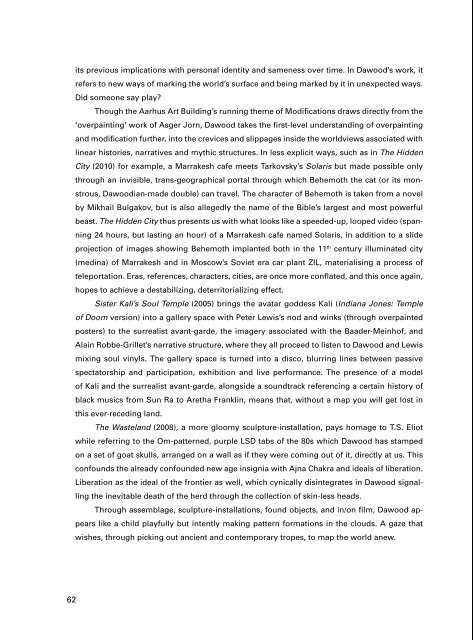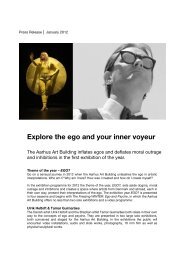eller - Århus Kunstbygning
eller - Århus Kunstbygning
eller - Århus Kunstbygning
Create successful ePaper yourself
Turn your PDF publications into a flip-book with our unique Google optimized e-Paper software.
62<br />
its previous implications with personal identity and sameness over time. In Dawood’s work, it<br />
refers to new ways of marking the world’s surface and being marked by it in unexpected ways.<br />
Did someone say play?<br />
Though the Aarhus Art Building’s running theme of Modifications draws directly from the<br />
‘overpainting’ work of Asger Jorn, Dawood takes the first-level understanding of overpainting<br />
and modification further, into the crevices and slippages inside the worldviews associated with<br />
linear histories, narratives and mythic structures. In less explicit ways, such as in The Hidden<br />
City (2010) for example, a Marrakesh cafe meets Tarkovsky’s Solaris but made possible only<br />
through an invisible, trans-geographical portal through which Behemoth the cat (or its mon-<br />
strous, Dawoodian-made double) can travel. The character of Behemoth is taken from a novel<br />
by Mikhail Bulgakov, but is also allegedly the name of the Bible’s largest and most powerful<br />
beast. The Hidden City thus presents us with what looks like a speeded-up, looped video (span-<br />
ning 24 hours, but lasting an hour) of a Marrakesh cafe named Solaris, in addition to a slide<br />
projection of images showing Behemoth implanted both in the 11 th century illuminated city<br />
(medina) of Marrakesh and in Moscow’s Soviet era car plant ZIL, materialising a process of<br />
teleportation. Eras, references, characters, cities, are once more conflated, and this once again,<br />
hopes to achieve a destabilizing, deterritorializing effect.<br />
Sister Kali’s Soul Temple (2005) brings the avatar goddess Kali (Indiana Jones: Temple<br />
of Doom version) into a gallery space with Peter Lewis’s nod and winks (through overpainted<br />
posters) to the surrealist avant-garde, the imagery associated with the Baader-Meinhof, and<br />
Alain Robbe-Grillet’s narrative structure, where they all proceed to listen to Dawood and Lewis<br />
mixing soul vinyls. The gallery space is turned into a disco, blurring lines between passive<br />
spectatorship and participation, exhibition and live performance. The presence of a model<br />
of Kali and the surrealist avant-garde, alongside a soundtrack referencing a certain history of<br />
black musics from Sun Ra to Aretha Franklin, means that, without a map you will get lost in<br />
this ever-receding land.<br />
The Wasteland (2008), a more gloomy sculpture-installation, pays homage to T.S. Eliot<br />
while referring to the Om-patterned, purple LSD tabs of the 80s which Dawood has stamped<br />
on a set of goat skulls, arranged on a wall as if they were coming out of it, directly at us. This<br />
confounds the already confounded new age insignia with Ajna Chakra and ideals of liberation.<br />
Liberation as the ideal of the frontier as well, which cynically disintegrates in Dawood signal-<br />
ling the inevitable death of the herd through the collection of skin-less heads.<br />
Through assemblage, sculpture-installations, found objects, and in/on film, Dawood ap-<br />
pears like a child playfully but intently making pattern formations in the clouds. A gaze that<br />
wishes, through picking out ancient and contemporary tropes, to map the world anew.<br />
• Ghalya Saadawi is an independent writer, editor and researcher. Some of her articles have ap-<br />
peared in Bidoun, Canvas, The Daily Star and the online art magazines Nowiswere and Frieze.<br />
com. She is co-editor of Untitled Tracks: On Alternative Music in Beirut (2010). Saadawi is cur-<br />
rently a PhD candidate at Goldsmiths College in London where she is researching questions of<br />
witness, testimony and fiction in contemporary artistic production in Lebanon and beyond.<br />
1 Hakim Bey: T.A.Z: The Temporary Autonomous Zone, Ontological Anarchy, Poetic Terrorism, Brook-<br />
lyn NY: Autonomedia, 1985, 1991, 2003.<br />
2 Frederic Jackson Turner: The Frontier in American History, Mineola: Dover Publications, 1996.<br />
3 Eugene W. Holland: Deleuze and Guattari’s Anti-Oedipus: Introduction to Schizoanalysis, London &<br />
New York: Routledge 1999, 2001, p. 71.<br />
4 Randy Kennedy: “Writers Who Like to Borrow” (oprindelig fra The New York Times, optrykt i The<br />
Observer, søndag d. 14 marts, 2010), p. 8.<br />
5 Fredric Jameson: The Cultural Turn: Selected Writings on the Postmodern 1983-1998, London & New<br />
York: Verso 1998, pp. 63-64.<br />
6 Ibid, p. 64.<br />
7 Gilles Deleuze: Pure Immanence: Essay on A Life, New York: Zone Books 2005, p. 11.



